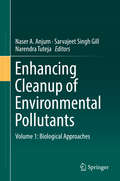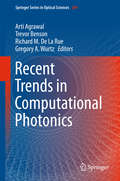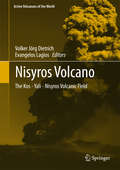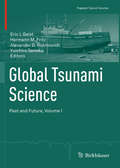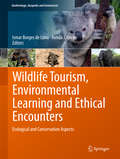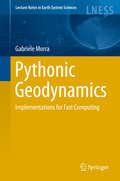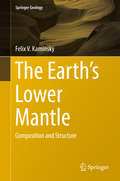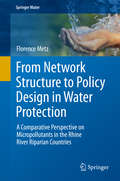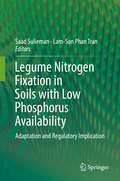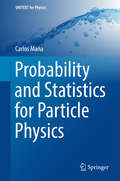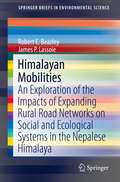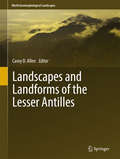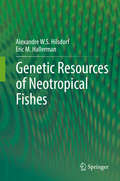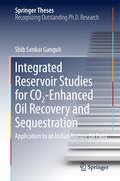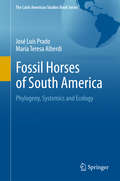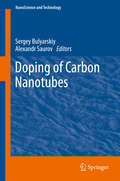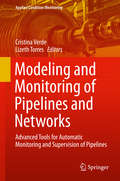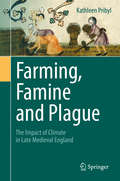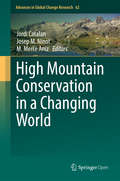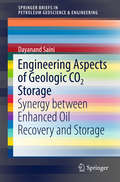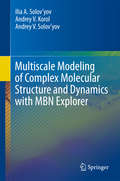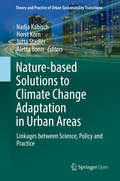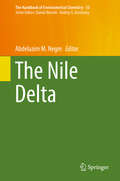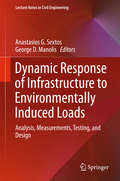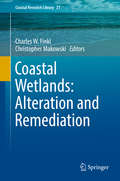- Table View
- List View
Enhancing Cleanup of Environmental Pollutants: Volume 1: Biological Approaches
by Naser A. Anjum Sarvajeet Singh Gill Narendra TutejaThis two-volume work is an effort to provide a common platform to environmental engineers, microbiologists, chemical scientists, plant physiologists and molecular biologists working with a common aim of sustainable solutions to varied environmental contamination issues. Chapters explore biological and non-biological strategies to minimize environmental pollution. Highly readable entries attempt to close the knowledge gap between plant - microbial associations and environmental remediation.Volume 1 focuses on important concepts such as biological remediation strategies to enhance soil quality at contaminated sites; synergistic influences of tolerant plants and rhizospheric microbial strains on the remediation of pesticide contaminated soil, and the role of plant types such as hyperaccumulator plants in the cleanup of polluted soils. Readers will discover mechanisms and underlying natural inherent traits of various plants and microbes for tolerating, excluding, remediating, accumulating, or metabolizing a variety of pollutants.
Recent Trends in Computational Photonics (Springer Series in Optical Sciences #204)
by Arti Agrawal Trevor Benson Richard M. De La Rue Gregory A. WurtzThis book brings together the recent cutting-edge work on computational methods in photonics and their applications. The latest advances in techniques such as the Discontinuous Galerkin Time Domain method, Finite Element Time Domain method, Finite Difference Time Domain method as well as their applications are presented. Key aspects such as modelling of non-linear effects (Second Harmonic Generation, lasing in fibers, including gain nonlinearity in metamaterials), the acousto-optic effect, and the hydrodynamic model to explain electron response in nanoplasmonic structures are included. The application areas covered include plasmonics, metamaterials, photonic crystals, dielectric waveguides, fiber lasers. The chapters give a representative survey of the corresponding area.
Nisyros Volcano: The Kos - Yali - Nisyros Volcanic Field (Active Volcanoes of the World)
by Volker Jörg Dietrich Evangelos LagiosThis book presents the first compilation of scientific research on the island of Nisyros, involving various geoscientific disciplines. Presenting a wealth of illustrations and maps, including a geological map of the volcano, it also provides valuable insights into the geothermal potential of Greece. The island of Nisyros is a Quaternary volcano located at the easternmost end of the South Aegean Volcanic Arc. The island is nearly circular, with an average diameter of 8 km, and covers an area of approximately 42 km2. It lies above a base of Mesozoic limestone and a thin crust, with the mantle-crust transition located at a depth of approximately 27 km. The volcanic edifice of Nisyros comprises a succession of calc-alkaline lavas and pyroclastic rocks, as well as a summit caldera with an average diameter of 4 km. Nisyros marks the most recent volcano in the large prehistoric volcanic field between Kos-Yali-Strongyli-Pyrgousa-Pachia-Nisyros, where the largest eruption (“Kos Plateau Tuff”) in the history of the eastern Mediterranean devastated the Dodecanese islands 161,000 years ago. Although the last volcanic activity on Nisyros dates back at least 20,000 to 25,000 years, it encompasses an active hydrothermal system underneath the volcano with temperatures of roughly 100°C at the Lakki plain, the present-day caldera floor and 350°C at a depth of 1,550 m. A high level of seismic unrest, thermal waters and fumarolic gases bear testament to its continuous activity, which is due to a large volume of hot rocks and magma batches at greater depths, between 3,000 and 8,000 m. Violent hydrothermal eruptions accompanied by major earthquakes occurred in 1873 and 1888 and left behind large, “world-wide unique” explosion craters in the old caldera. Through diffuse soil degassing, the discharge of all hydrothermal craters in the Lakki plain releases 68 tons of hydrothermal-volcanic derived CO2 and 42 MW of thermal energy per day. This unique volcanic and hydrothermal environment is visited daily by hundreds of tourists.
Global Tsunami Science: Past and Future, Volume I (Pageoph Topical Volumes)
by Eric L Geist Hermann M. Fritz Alexander B. Rabinovich Yuichiro TaniokaTsunami science has evolved significantly since the occurrence of two of the most destructive natural disasters in recent times: the 26 December 2004 Sumatra tsunami that killed about 230,000 people along the coasts of 14 countries in the Indian Ocean and the 11 March 2011 Tohoku (Great East Japan) tsunami that killed almost 20,000 people and destroyed the Fukushima Daiichi nuclear power plant. As a result of these and many other destructive tsunamis that have occurred over just the last decade, scientists from around the world have come together to engage in tsunami research. The global community of researchers has also expanded by discipline, adapting advances in other sciences to study all aspects of tsunami hydrodynamics, detection, generation, and probability of occurrence. The papers presented in this first of two topical volumes of Pure and Applied Geophysics reflect the state of tsunami science during this time. Nine papers examine various aspects of tsunami hazard and risk assessment. Five papers present new methods for tsunami warning and detection and six other papers describe new methods for understanding tsunami hydrodynamics. The final five papers of the volume describe tsunamis generated by non-seismic sources and important case studies. Collectively, this volume highlights contemporary trends in global tsunami science, both fundamental and applied toward hazard assessment and mitigation. The volume is of interest to scientists and practitioners involved in all aspects of tsunamis from source processes to coastal impacts. Postgraduate students in geophysics, oceanography and coastal engineering – as well as students in the broader geosciences, civil and environmental engineering – will also find the book to be a valuable resource, as it combines recent case studies with advances in tsunami science and natural hazards mitigation.
Wildlife Tourism, Environmental Learning and Ethical Encounters: Ecological and Conservation Aspects (Geoheritage, Geoparks and Geotourism)
by Ismar Borges de Lima Ronda J. GreenThis book outlines the status quo of worldwide wildlife tourism and its impacts on planning, management, knowledge, awareness, behaviour and attitudes related to wildlife encounters. It sets out to fill the considerable gaps in our knowledge on wildlife tourism, applied ecology, and environmental education, providing comprehensive information on and an interdisciplinary approach to effective management in wildlife tourism. Examining the intricacies, challenges, and lessons learned in a meaningful and rewarding tourism niche, this interdisciplinary book comprehensively examines the major potentials and controversies in the wildlife tourism industry. Pursuing an insightful, provocative and hands-on approach, it primarily addresses two questions: ‘Can we reconcile the needs of the wildlife tourism industry, biodiversity conservation, ecological learning and animal ethics issues?’ and ‘What is the Future of the Wildlife Tourism Industry?’. Though primarily intended as a research text, it also offers a valuable resource for a broad readership, which includes university and training students, researchers, scholars, tourism practitioners and professionals, planners and managers, as well as the staff of government agencies.
Pythonic Geodynamics: Implementations for Fast Computing (Lecture Notes in Earth System Sciences)
by Gabriele MorraThis book addresses students and young researchers who want to learn to use numerical modeling to solve problems in geodynamics. Intended as an easy-to-use and self-learning guide, readers only need a basic background in calculus to approach most of the material. The book difficulty increases very gradually, through four distinct parts. The first is an introduction to the Python techniques necessary to visualize and run vectorial calculations. The second is an overview with several examples on classical Mechanics with examples taken from standard introductory physics books. The third part is a detailed description of how to write Lagrangian, Eulerian and Particles in Cell codes for solving linear and non-linear continuum mechanics problems. Finally the last one address advanced techniques like tree-codes, Boundary Elements, and illustrates several applications to Geodynamics. The entire book is organized around numerous examples in Python, aiming at encouraging the reader to learn by experimenting and experiencing, not by theory.
The Earth's Lower Mantle: Composition and Structure (Springer Geology)
by Felix V. KaminskyThis book presents the first overview of the composition and structure of the Earth’s lower mantle. The first part focuses on the study of lower-mantle minerals, identified as inclusions in diamonds from different regions of the world. Three associations are established among the lower-mantle minerals: ultramafic, mafic, and carbonatic. The carbonatic association is of particular interest because it characterizes the media of natural diamond formation. In turn, the second part analyzes the structure of the lower mantle, revealing its heterogeneous composition. It is based on the results of experiments demonstrating phase transitions in lower-mantle minerals, and on seismological data. Deep-seated earthquakes point to the presence within the lower mantle of numerous seismic boundaries caused by mineral structure transitions. In closing, the last part of the book compares observed data with experimental data, highlighting several discrepancies that indicate Earth may have a more complex planetary history than previously assumed, and examining its primarily non-chondritic composition.
From Network Structure to Policy Design in Water Protection: A Comparative Perspective on Micropollutants in the Rhine River Riparian Countries (Springer Water)
by Florence MetzThe book examines a new concern in water quality policy, namely aquatic micropollutants. Micropollutants are chemicals detected in small concentrations in waterbodies today, originating from pharmaceuticals, cosmetics, or detergents, among others. Since the regulation of micropollutants is a fairly new issue, it has been largely neglected in social sciences. However, the search for appropriate solutions is of high political relevance at both the national and international levels, with many open questions arising that concern the most adequate governance structures and steering mechanisms. Solutions suitable for classical, macro-pollutants, such as nutrients, do not necessarily apply to micropollutants because of the diversity of compounds and sources, and for technical, financial, and societal reasons. The book addresses this knowledge gap by investigating the steering mechanisms at hand and their prospect for problem solving. In this regard, the research provides a systematic depiction and comparison of policy designs in place for the reduction of micropollutants in the Rhine basin. Moreover, the study yields insights into the governance structures in place, into actors’ responsibilities and constellations, and policy processes regarding micropollutants. The study is furthermore embedded into broader theoretical questions of policy research. More precisely, this research is a contribution to policy analysis that aims to achieve more optimal policy results by providing for a better understanding of the nature of policy designs and the social mechanisms behind the choice of them. Despite the intrinsic aim of policy analysis at contributing to more optimal policy outcomes, there remains a lack of research regarding analytical tools that enable an ex-ante assessment of policy designs’ problem-solving abilities. To explore such a research path, this book proposes a novel index of policy comprehensiveness for quantifying the prospective performance of policy designs in alleviating an underlying policy issue, e.g. reducing pollutants in waters.Furthermore, the book uncovers the social mechanisms behind policymaking and turns to the question: In which social settings is it possible to achieve a comprehensive policy design? Compared to purely micro-level explanations, the advantage of the network approach is that it goes beyond the mere aggregation of policy actors’ attributes by taking into consideration actors’ interdependencies. In order to take the network approach seriously, the study systematically links the structure of a policy network with comprehensive policy designs. Network concepts, such as coalition structure, interconnectedness, and belief similarity, are employed from policy change research here in order to explore the link between structural network characteristics and comprehensive policy design. By studying how network structures affect policy design, the book critically examines the explanatory value of the network approach.
Legume Nitrogen Fixation in Soils with Low Phosphorus Availability: Adaptation and Regulatory Implication
by Saad Sulieman Lam-Son Phan TranThis thoughtful and provocative book provides a concise, up-to-date presentation of how current and projected future phosphorus scarcity will affect legume growth and their symbiotic nitrogen-fixing capabilities. It is a timely examination of the physiological and molecular responses of nodules to phosphorous deficiency in attempt to identify common principles. Students and researchers in the many disciplines related to crop productivity will find this title an exciting contribution in the area of plant stress physiology. The knowledge in this volume can also aid plant breeders, particularly through new methods of genetic engineering, in developing unique and adaptive cultivars with higher symbiotic efficiency.The awareness of the rapidly rising world population must translate into a parallel increase in agricultural production in order to sustain the growing population both now and in the future. Hence, the demand for food crops to produce proteins and vegetable oil for human consumption is going to increase considerably during the coming years. The essential role of legumes in agriculture is well-recognized, given the abundant levels of proteins and oils found in plants along with their enormous contribution to the sustainability of agricultural systems and human health. The capacity of legumes to fix nitrogen (N2) in partnership with rhizobia provides an input-saving and resource-conserving alternative, thereby reducing the need for chemical fertilizers while enhancing overall crop productivity. The use of N2-fixing legumes to produce plant proteins results in a substantial decrease in the consumption of fossil fuels and therefore also in the agricultural effects to global warming. However, a major constraint to legume production is low soil phosphorus (P) availability, considering that an overwhelming majority of the world’s soils are classified as P-deficient. Low-P availability is especially problematic for legumes, since legume nodules responsible for N2 fixation have a high P requirement. Therefore, this book explains how nodule N2 fixation responds to low P availability, which is crucial for improving legume production and maintaining agricultural sustainability in the context of the global P crisis.
Probability and Statistics for Particle Physics (UNITEXT for Physics)
by Carlos MañaThis book comprehensively presents the basic concepts of probability and Bayesian inference with sufficient generality to make them applicable to current problems in scientific research. The first chapter provides the fundamentals of probability theory that are essential for the analysis of random phenomena. The second chapter includes a full and pragmatic review of the Bayesian methods that constitute a natural and coherent framework with enough freedom to analyze all the information available from experimental data in a conceptually simple manner. The third chapter presents the basic Monte Carlo techniques used in scientific research, allowing a large variety of problems to be handled difficult to tackle by other procedures. The author also introduces a basic algorithm, which enables readers to simulate samples from simple distribution, and describes useful cases for researchers in particle physics.The final chapter is devoted to the basic ideas of Information Theory, which are important in the Bayesian methodology. This highly readable book is appropriate for graduate-level courses, while at the same time being useful for scientific researches in general and for physicists in particular since most of the examples are from the field of Particle Physics.
Himalayan Mobilities: An Exploration of the Impact of Expanding Rural Road Networks on Social and Ecological Systems in the Nepalese Himalaya (SpringerBriefs in Environmental Science)
by Robert E. Beazley James P. LassoieThe goals of this book are to update information on the effects of rural road development, both in Nepal and globally, explain the environmental, socioeconomic, and sociocultural impacts of expanding rural road networks in the Nepalese Himalaya, and to promote further studies on rural road development throughout the world based on studies and investigations performed in Nepal. Readers will learn about the history of rural road development, as well as the challenges to effectively design and construct rural roads and how these obstacles may be overcome.Chapter one offers a global review of road development, and both the positive and negative impacts of rural road implementation. Chapter two defines mobilities within the context of coupled social and ecological systems, specifically in the Nepalese Himalaya. Chapters three through five detail the environmental, socioeconomic, and sociocultural impacts expanding rural road networks through several case studies. The concluding chapter summarizes the findings of the book, discussing the need for interdisciplinary cooperation and collaboration to avoid negative consequences. This book will be of interest to teachers, researchers, policy makers, and development organizations.
Landscapes and Landforms of the Lesser Antilles (World Geomorphological Landscapes)
by Casey D. AllenThis book focuses on the highly touristed, but surprisingly under-researched Lesser Antilles region. After offering a brief overview of the region’s geologic and tectonic history, as well as its basic climatology, subsequent chapters then discuss each island’s (or island set’s) geomorphology and geology, and how the settlement history, tourism, and hazards have affected their individual landscapes. Written by regional experts and replete with up-to-date information, stunning color imagery, and beautiful cartography (maps), it is the only comprehensive, scientific evaluation of the Lesser Antilles, and serves as the region’s definitive reference resource. Accessible to non-experts and amateur explorers, the book includes in-depth discussions and reference sections for each island/island set. Usable as both a textbook and guidebook, it offers readers a straightforward yet detailed assessment of an interesting and intriguing – but often-overlooked and under-appreciated – locale.
Genetic Resources of Neotropical Fishes
by Alexandre W. Hilsdorf Eric M. HallermanThe aim of this book is to systematize and discuss population genetic studies of freshwater fish in a region that harbors the greatest diversity of species among all inland water ecosystems. This volume explores the genetic evaluation for a number of orders, families and species of Neotropical fishes, and provides an overview on genetic resources and diversity and their relationships with fish domestication, breeding, and food production.
Integrated Reservoir Studies for CO2-Enhanced Oil Recovery and Sequestration: Application to an Indian Mature Oil Field (Springer Theses)
by Shib Sankar GanguliThis book addresses the feasibility of CO2-EOR and sequestration in a mature Indian oil field, pursuing for the first time a cross-disciplinary approach that combines the results from reservoir modeling and flow simulation, rock physics modeling, geomechanics, and time-lapse (4D) seismic monitoring study. The key findings presented indicate that the field under study holds great potential for enhanced oil recovery (EOR) and subsequent CO2 storage. Experts around the globe argue that storing CO2 by means of enhanced oil recovery (EOR) could support climate change mitigation by reducing the amount of CO2 emissions in the atmosphere by ca. 20%. CO2-EOR and sequestration is a cutting-edge and emerging field of research in India, and there is an urgent need to assess Indian hydrocarbon reservoirs for the feasibility of CO2-EOR and storage. Combining the fundamentals of the technique with concrete examples, the book is essential reading for all researchers, students and oil & gas professionals who want to fully understand CO2-EOR and its geologic sequestration process in mature oil fields.
Fossil Horses of South America: Phylogeny, Systemics and Ecology (The Latin American Studies Book Series)
by José Luis Prado María Teresa AlberdiThis book provides an update on the phylogeny, systematics and ecology of horses in South America based on data provided over the past three decades. The contemporary South American mammalian communities were shaped by the emergence of the Isthmus of Panama and by the profound climatic oscillations during the Pleistocene. Horses were a conspicuous group of immigrant mammals from North America that arrived in South America during the Pleistocene. This group is represented by 2 genera, Hippidion and Equus, which include small species (Hippidion devillei, H. saldiasi, E. andium and E. insulatus) and large forms (Equus neogeus and H. principale). Both groups arrived in South America via 2 different routes. One model designed to explain this migration indicates that the small forms used the Andes corridor, while larger horses used the eastern route and arrived through some coastal areas. Molecular dating (ancient DNA) suggests that the South American horses separated from the North American taxa (caballines and the New World stilt-legged horse) after 3.6 - 3.2 Ma, consistent with the final formation of the Panamanian Isthmus. Recent studies of stable isotopes in these horses indicate an extensive range of 13C values cover closed woodlands to C4 grasslands. This plasticity agrees with the hypothesis that generalist species and open biome specialist species from North America indicate a positive migration through South America.
Doping of Carbon Nanotubes (NanoScience and Technology)
by Sergey Bulyarskiy Alexandr SaurovThis book addresses the control of electronic properties of carbon nanotubes. It presents thermodynamic calculations of the formation of impurities and defects in the interaction of nanotubes with hydrogen, oxygen, nitrogen and boron, based on theoretical models of the formation of defects in carbon nanotubes. It is shown that doping and adsorption lead to changes in the electronic structure of the tubes as well as to the appearance of impurity states in the HOMO-LUMO gap. The book presents examples of specific calculations for doping of carbon nanotubes with oxygen, hydrogen, nitrogen and boron, together with numerous experimental results and a comparison with the author’s thermodynamic calculations. Possible directions of the technological processes of optimization are pointed out, as well as the perspectives of p-n-transition creation with the help of carbon nanotube arrays. The results presented were derived from the physics of the processes and a theoretical model of the technological processes. Though a wealth of empirical information on doping nanotubes has been accumulated in the scientific literature, what is lacking is a theoretical model for their analysis. As such, the book develops a thermodynamic model of the self-organization of structural elements in multicomponent systems – including carbon nanotubes, clusters and precipitates in condensed matter – and subsequently adapts it to the doping of carbon nanotubes. This approach allows readers to gain a far deeper understanding of the processes of doping carbon nanotubes.
Modeling and Monitoring of Pipelines and Networks: Advanced Tools for Automatic Monitoring and Supervision of Pipelines (Applied Condition Monitoring #7)
by Cristina Verde Lizeth TorresThis book focuses on the analysis and design of advanced techniques for on-line automatic computational monitoring of pipelines and pipe networks. It discusses how to improve the systems’ security considering mathematical models of the flow, historical flow rate and pressure data, with the main goal of reducing the number of sensors installed along a pipeline. The techniques presented in the book have been implemented in digital systems to enhance the abilities of the pipeline network’s operators in recognizing anomalies. A real leak scenario in a Mexican water pipeline is used to illustrate the benefits of these techniques in locating the position of a leak. Intended for an interdisciplinary audience, the book addresses researchers and professionals in the areas of mechanical, civil and control engineering. It covers topics on fluid mechanics, instrumentation, automatic control, signal processing, computing, construction and diagnostic technologies.
Farming, Famine and Plague: The Impact of Climate in Late Medieval England
by Kathleen PribylThis book is situated at the cross-roads of environmental, agricultural and economic history and climate science. It investigates the climatic background for the two most significant risk factors for life in the crisis-prone England of the Later Middle Ages: subsistence crisis and plague. Based on documentary data from eastern England, the late medieval growing season temperature is reconstructed and the late summer precipitation of that period indexed. Using these data, and drawing together various other regional (proxy) data and a wide variety of contemporary documentary sources, the impact of climatic variability and extremes on agriculture, society and health are assessed. Vulnerability and resilience changed over time: before the population loss in the Great Pestilence in the mid-fourteenth century meteorological factors contributing to subsistence crises were the main threat to the English people, after the arrival of Yersinia pestis it was the weather conditions that faciliated the formation of recurrent major plague outbreaks.Agriculture and harvest success in late medieval England were inextricably linked to both short term weather extremes and longer term climatic fluctuations. In this respect the climatic transition period in the Late Middle Ages (c. 1250-1450) is particularly important since the broadly favourable conditions for grain cultivation during the Medieval Climate Optimum gave way to the Little Ice Age, when agriculture was faced with many more challenges; the fourteenth century in particular was marked by high levels of climatic variability.
High Mountain Conservation in a Changing World (Advances in Global Change Research #62)
by Jordi Catalan Josep M Ninot M. Mercè AnizThis book provides case studies and general views of the main processes involved in the ecosystem shifts occurring in the high mountains and analyses the implications for nature conservation. Case studies from the Pyrenees are preponderant, with a comprehensive set of mountain ranges surrounded by highly populated lowland areas also being considered.The introductory and closing chapters will summarise the main challenges that nature conservation may face in mountain areas under the environmental shifting conditions. Further chapters put forward approaches from environmental geography, functional ecology, biogeography, and paleoenvironmental reconstructions. Organisms from microbes to large carnivores, and ecosystems from lakes to forest will be considered.This interdisciplinary book will appeal to researchers in mountain ecosystems, students and nature professionals. This book is open access under a CC BY license.
Engineering Aspects of Geologic CO2 Storage: Synergy between Enhanced Oil Recovery and Storage (SpringerBriefs in Petroleum Geoscience & Engineering)
by Dayanand SainiThis timely book explores the lessons learned in and potentials of injecting supercritical CO2 into depleted oil and gas reservoirs, in order to maximize both hydrocarbon recovery and the storage capacities of injected CO2.The author provides a detailed discussion of key engineering parameters of simultaneous CO2 enhanced oil recovery and CO2 storage in depleted hydrocarbon reservoirs. These include candidate site selection, CO2 oil miscibility, maximizing CO2-storage capacity in enhanced oil recovery operations, well configurations, and cap and reservoir rock integrity. The book will help practicing professionals devise strategies to curb greenhouse gas emissions from the use of fossil fuels for energy production via geologic CO2 storage, while developing CO2 injection as an economically viable and environmentally sensible business model for hydrocarbon exploration and production in a low carbon economy.
Multiscale Modeling of Complex Molecular Structure and Dynamics with MBN Explorer
by Ilia A. Solov’yov Andrey V. Korol Andrey V. Solov’yovThis book introduces readers to MesoBioNano (MBN) Explorer – a multi-purpose software package designed to model molecular systems at various levels of size and complexity. In addition, it presents a specially designed multi-task toolkit and interface – the MBN Studio – which enables the set-up of input files, controls the simulations, and supports the subsequent visualization and analysis of the results obtained. The book subsequently provides a systematic description of the capabilities of this universal and powerful software package within the framework of computational molecular science, and guides readers through its applications in numerous areas of research in bio- and chemical physics and material science – ranging from the nano- to the mesoscale. MBN Explorer is particularly suited to computing the system’s energy, to optimizing molecular structure, and to exploring the various facets of molecular and random walk dynamics. The package allows the use of a broad variety of interatomic potentials and can, e.g., be configured to select any subset of a molecular system as rigid fragments, whenever a significant reduction in the number of dynamical degrees of freedom is required for computational practicalities. MBN Studio enables users to easily construct initial geometries for the molecular, liquid, crystalline, gaseous and hybrid systems that serve as input for the subsequent simulations of their physical and chemical properties using MBN Explorer. Despite its universality, the computational efficiency of MBN Explorer is comparable to that of other, more specialized software packages, making it a viable multi-purpose alternative for the computational modeling of complex molecular systems. A number of detailed case studies presented in the second part of this book demonstrate MBN Explorer’s usefulness and efficiency in the fields of atomic clusters and nanoparticles, biomolecular systems, nanostructured materials, composite materials and hybrid systems, crystals, liquids and gases, as well as in providing modeling support for novel and emerging technologies. Last but not least, with the release of the 3rd edition of MBN Explorer in spring 2017, a free trial version will be available from the MBN Research Center website (mbnresearch.com).
Nature-Based Solutions to Climate Change Adaptation in Urban Areas: Linkages between Science, Policy and Practice (Theory and Practice of Urban Sustainability Transitions)
by Nadja Kabisch Horst Korn Jutta Stadler Aletta BonnThis open access book brings together research findings and experiences from science, policy and practice to highlight and debate the importance of nature-based solutions to climate change adaptation in urban areas. Emphasis is given to the potential of nature-based approaches to create multiple-benefits for society.The expert contributions present recommendations for creating synergies between ongoing policy processes, scientific programmes and practical implementation of climate change and nature conservation measures in global urban areas.Except where otherwise noted, this book is licensed under a Creative Commons Attribution 4.0 International License. To view a copy of this license, visit http://creativecommons.org/licenses/by/4.0/
The Nile Delta (The Handbook of Environmental Chemistry #55)
by Abdelazim M. NegmThis volume presents up-to-date research on the Nile Delta and discusses the challenges involved in and opportunities for improving its productivity. The topics addressed include: groundwater in the Nile Delta and its quality; the mapping of groundwater with remote sensing technologies; land degradation; salt-affected soils; on-farm irrigation; the remediation of agricultural drainage water for sustainable reuse; the use of satellite images to estimate the bathymetry of coastal lakes; the assessment of the Nile Delta coastal zone and its management; its sediment and water quality; and fishing ports, fish and fisheries. The book closes with a review of the latest findings on the Nile Delta and offers conclusions and recommendations for future research to fulfill the requirements for sustainable development. It provides a unique and topical resource for researchers, graduate students and policymakers alike.
Dynamic Response of Infrastructure to Environmentally Induced Loads: Analysis, Measurements, Testing, and Design (Lecture Notes in Civil Engineering #2)
by Anastasios G. Sextos George D. ManolisThis book provides state of the art coverage of important current issues in the analysis, measurement, and monitoring of the dynamic response of infrastructure to environmental loads, including those induced by earthquake motion and differential soil settlement. The coverage is in five parts that address numerical methods in structural dynamics, soil–structure interaction analysis, instrumentation and structural health monitoring, hybrid experimental mechanics, and structural health monitoring for bridges. Examples that give an impression of the scope of the topics discussed include the seismic analysis of bridges, soft computing in earthquake engineering, use of hybrid methods for soil–structure interaction analysis, effects of local site conditions on the inelastic dynamic analysis of bridges, embedded models in wireless sensor networks for structural health monitoring, recent developments in seismic simulation methods, and seismic performance assessment and retrofit of structures. Throughout, the emphasis is on the most significant recent advances and new material. The book comprises extended versions of contributions delivered at the DE-GRIE Lab Workshop 2014, held in Thessaloniki, Greece, in November 2014.
Coastal Wetlands: Alteration and Remediation (Coastal Research Library #21)
by Charles W. Finkl Christopher MakowskiThis book delves into human-induced and natural impacts on coastal wetlands, intended or otherwise, through a series of vignettes that elucidate the environmental insults and efforts at amelioration and remediation. The alteration, and subsequent restoration, of wetland habitats remain key issues among coastal scientists. These topics are introduced through case studies and pilot programs that are designed to better understand the best practices of trying to save what is left of these fragile ecosystems. Local approaches, as well as national and international efforts to restore the functionality of marsh systems are summarily approached and evaluated by their efficacy in producing resilient reclamations in terms of climate-smart habitat conservation. The outlook of this work is global in extent and local by intent. Included here in summarized form are professional opinions of experts in the field that investigate the crux of the matter, which proves to be human pressure on coastal wetland environments. Even though conservation and preservation of these delicate environmental systems may be coming at a later date, many multi-pronged approaches show promise through advances in education, litigation, and engineering to achieve sustainable coastal systems. The examples in this book are not only of interest to those working exclusively with coastal wetlands, but also to those working to protect the surrounding coastal areas of all types.
